Microwave Absorption Performance of Carbon Black/Polylactic Acid Composite for Fused Filament Fabrication
Abstract
:1. Introduction
2. Materials and Methods
2.1. Materials
2.2. CB/PLA Composites Preparation
2.3. Experimental Design
2.4. Test and Characterization
3. Results and Discussion
3.1. Structure and Micromorphology of Raw Materials and Composites
3.2. Electromagnetic Parameters and Loss Mechanisms of Composites
3.3. Microwave Absorption Performance of Composites
4. Conclusions
Author Contributions
Funding
Institutional Review Board Statement
Informed Consent Statement
Data Availability Statement
Conflicts of Interest
References
- Cheng, Y.; Zhu, W.; Lu, X.; Wang, C. Recent Progress of Electrospun Nanofibrous Materials for Electromagnetic Interference Shielding. Compos. Commun. 2021, 27, 100823–100833. [Google Scholar] [CrossRef]
- Wang, H.Y.; Sun, X.B.; Wang, G.S. A MXene-modulated 3D Crosslinking Network of Hierarchical Flower-Like MOF Derivatives Towards Ultra-Efficient Microwave Absorption Properties. J. Mater. Chem. A Mater. Energy Sustain. 2021, 9, 24571–24581. [Google Scholar] [CrossRef]
- Zhang, Y.; Li, S.; Tang, X.; Fan, W.; Lan, Q.; Li, L.; Ma, P.; Dong, W.; Wang, Z.; Liu, T. Ultralight and Ordered Lamellar Polyimide-Based Graphene Foams with Efficient Broadband Electromagnetic Absorption. J. Mater. Sci. Technol. 2022, 102, 97–104. [Google Scholar] [CrossRef]
- Li, S.; Li, W.; Nie, J.; Liu, D.; Sui, G. Synergistic Effect of Graphene Nanoplate and Carbonized Loofah Fiber on the Electromagnetic Shielding Effectiveness of PEEK-based Composites. Carbon 2019, 143, 154–161. [Google Scholar] [CrossRef]
- Han, M.; Yin, X.; Hou, Z.; Song, C.; Li, X.; Zhang, L.; Cheng, L. Flexible and Thermostable Graphene/SiC Nanowire Foam Composites with Tunable Electromagnetic Wave Absorption Properties. ACS Appl. Mater. Inter. 2017, 9, 11803–11810. [Google Scholar] [CrossRef] [PubMed]
- Tong, L.; Chenwei, Z.; Jia, L.; Xiangyu, M.; Yuanxun, G.; Hongjie, Z. Research Progress in Metamaterial Absorber. Acta Mater. Compos. Sin. 2021, 38, 25–35. (In Chinese) [Google Scholar]
- Cui, L.; Han, X.; Wang, F.; Zhao, H.; Du, Y. A Review on Recent Advances in Carbon-Based Dielectric System for Microwave Absorption. J. Mater. Sci. 2021, 56, 10782–10811. [Google Scholar] [CrossRef]
- Green, M.; Chen, X. Recent Progress of Nanomaterials for Microwave Absorption. J. Mater. 2019, 5, 503–541. [Google Scholar] [CrossRef]
- Yang, W.; Jiang, B.; Che, S.; Yan, L.; Li, Z.; Li, Y. Research Progress on Carbon-Based Materials for Electromagnetic Wave Absorption and the Related Mechanisms. New Carbon Mater. 2021, 36, 1016–1030. [Google Scholar] [CrossRef]
- Lingyun, L.; Meilin, Z.; Jinxia, X.; Zhiheng, L. Study on the Absorbing Properties of Tetraneedle Zinc Oxide/Carbon Black Composite Absorbers. Opt. Optoelectron. Technol. 2021, 19, 7–12. (In Chinese) [Google Scholar]
- Tang, J.; Bi, S.; Wang, X.; Hou, G.; Su, X.; Liu, C.; Lin, Y.; Li, H. Excellent Microwave Absorption of Carbon Black/Reduced Graphene Oxide Composite with Low Loading. J. Mater. Sci. 2019, 54, 13990–14001. [Google Scholar] [CrossRef]
- Xianyun, H.; Bo, Y.; Xinghua, Z. Research on the Microwave Absorbing Properties of Ferrite/Acetylene Carbon Black Composites with Different Structures. J. Phys. Conf. Ser. 2021, 1948, 012198–012202. [Google Scholar] [CrossRef]
- Wang, F.; Zhou, Q.; Zhang, Z.; Gu, Y.; Zhang, J.; Jiang, K. Microwave Absorption Properties of Carbon Black-Carbonyl Iron/Polylactic Acid Composite Filament for Fused Deposition Modeling. Materials 2022, 15, 5455–5468. [Google Scholar] [CrossRef] [PubMed]
- Wang, W.; Liu, D.; Cheng, H.; Cao, T.; Li, Y.; Deng, Y.; Xie, W. Structural design and broadband radar absorbing performance of multi-layer patch using carbon black. Adv. Compos. Hybrid Mater. 2022, 5, 3137–3145. [Google Scholar] [CrossRef]
- Qiu, Y.; Lin, Y.; Yang, H.; Wang, L.; Wang, M.; Wen, B. Hollow Ni/C Microspheres Derived from Ni-metal Organic Framework for Electromagnetic Wave Absorption. Chem. Eng. J. 2020, 383, 123207–123251. [Google Scholar] [CrossRef]
- Chai, L.; Wang, Y.; Zhou, N.; Du, Y.; Zeng, X.; Zhou, S.; He, Q.; Wu, G. In-Situ Growth of Core-Shell ZnFe2O4 @ Porous Hollow Carbon Microspheres as an Efficient Microwave Absorber. J. Colloid Interf. Sci. 2021, 581, 475–484. [Google Scholar] [CrossRef]
- Wang, H.; Ma, H. Enhancing the Microwave Absorbing Properties of Molybdenum Dioxide by Designing a Double-Layered Structure. Mater. Res. Bull. 2020, 122, 110692–110696. [Google Scholar] [CrossRef]
- Chen, Y.; Gao, P.; Wang, R.; Zhu, C.; Wang, L.; Cao, M.; Jin, H. Porous Fe3O4/SnO2 Core/Shell Nanorods: Synthesis and Electromagnetic Properties. J. Phys. Chem. C 2009, 113, 10061–10064. [Google Scholar] [CrossRef]
- Micheli, D.; Apollo, C.; Pastore, R.; Marchetti, M. X-Band Microwave Characterization of Carbon-Based Nanocomposite Material, Absorption Capability Comparison and RAS Design Simulation. Compos. Sci. Technol. 2010, 70, 400–409. [Google Scholar] [CrossRef]
- Zhang, X.; Cai, L.; Xiang, Z.; Lu, W. Hollow CuS Microflowers Anchored Porous Carbon Composites as Lightweight and Broadband Microwave Absorber with Flame-Retardant and Thermal Stealth Functions. Carbon 2021, 184, 514–525. [Google Scholar] [CrossRef]
- Lv, H.; Guo, Y.; Wu, G.; Ji, G.; Zhao, Y.; Xu, Z.J. Interface Polarization Strategy to Solve Electromagnetic Wave Interference Issue. ACS Appl. Mater. Inter. 2017, 9, 5660–5668. [Google Scholar] [CrossRef] [PubMed]
- Cheng, J.; Zhang, H.; Xiong, Y.; Gao, L.; Wen, B.; Raza, H.; Wang, H.; Zheng, G.; Zhang, D.; Zhang, H. Construction of Multiple Interfaces and Dielectric/Magnetic Heterostructures in Electromagnetic Wave Absorbers with Enhanced Absorption Performance: A Review. J. Mater. 2021, 7, 1233–1263. [Google Scholar] [CrossRef]
- Zhang, Z.; Cai, Z.; Wang, Z.; Peng, Y.; Xia, L.; Ma, S.; Yin, Z.; Huang, Y. A Review on Metal-Organic Framework-Derived Porous Carbon-Based Novel Microwave Absorption Materials. Nano-Micro Lett. 2021, 13, 56–84. [Google Scholar] [CrossRef]
- Xiang, Z.; Song, Y.; Xiong, J.; Pan, Z.; Wang, X.; Liu, L.; Liu, R.; Yang, H.; Lu, W. Enhanced Electromagnetic Wave Absorption of Nanoporous Fe3O4 @ Carbon Composites Derived from Metal-Organic Frameworks. Carbon 2019, 142, 20–31. [Google Scholar] [CrossRef]
- Liu, P.; Ng, V.M.H.; Yao, Z.; Zhou, J.; Lei, Y.; Yang, Z.; Lv, H.; Kong, L.B. Facile Synthesis and Hierarchical Assembly of Flowerlike NiO Structures with Enhanced Dielectric and Microwave Absorption Properties. ACS Appl. Mater. Inter. 2017, 9, 16404–16416. [Google Scholar] [CrossRef] [PubMed]
- Shi, Y.; Yu, L.; Li, K.; Li, S.; Meng, F. Well-Matched Impedance of Polypyrrole-Loaded Cotton Non-Woven Fabric/Polydimethylsiloxane Composite for Extraordinary Microwave Absorption. Compos. Sci. Technol. 2020, 197, 108246–108255. [Google Scholar] [CrossRef]
- Wang, H.; Sun, X.; Yang, S.; Zhao, P.; Zhang, X.; Wang, G.; Huang, Y. 3D Ultralight Hollow NiCo Compound@MXene Composites for Tunable and High-Efficient Microwave Absorption. Nano-Micro Lett. 2021, 13, 322–336. [Google Scholar] [CrossRef] [PubMed]
- Jiao, Z.; Huyan, W.; Yang, F.; Yao, J.; Tan, R.; Chen, P.; Tao, X.; Yao, Z.; Zhou, J.; Liu, P. Achieving Ultra-Wideband and Elevated Temperature Electromagnetic Wave Absorption via Constructing Lightweight Porous Rigid Structure. Nano-Micro Lett. 2022, 14, 173. [Google Scholar] [CrossRef]
- Pan, F.; Yu, L.; Xiang, Z.; Liu, Z.; Deng, B.; Cui, E.; Shi, Z.; Li, X.; Lu, W. Improved Synergistic Effect for Achieving Ultrathin Microwave Absorber of 1D Co nanochains/2D Carbide MXene Nanocomposite. Carbon 2021, 172, 506–515. [Google Scholar] [CrossRef]
- Jia, Z.; Kong, M.; Yu, B.; Ma, Y.; Pan, J.; Wu, G. Tunable Co/ZnO/C@MWCNTs Based on Carbon Nanotube-Coated MOF with Excellent Microwave Absorption Properties. J. Mater. Sci. Technol. 2022, 127, 153–163. [Google Scholar] [CrossRef]
- Wang, K.; Wan, G.; Wang, G.; He, Z.; Shi, S.; Wu, L.; Wang, G. The Construction of Carbon-Coated Fe3O4 Yolk-Shell Nanocomposites Based on Volume Shrinkage from the Release of Oxygen Anions for Wide-Band Electromagnetic Wave Absorption. J. Colloid Interf. Sci. 2018, 511, 307–317. [Google Scholar] [CrossRef] [PubMed]
- Wu, H.; Liu, J.; Liang, H.; Zang, D. Sandwich-Like Fe3O4/Fe3S4 Composites for Electromagnetic Wave Absorption. Chem. Eng. J. 2020, 393, 124743–124755. [Google Scholar] [CrossRef]
- Zhao, H.; Cheng, Y.; Zhang, Z.; Yu, J.; Zheng, J.; Zhou, M.; Zhou, L.; Zhang, B.; Ji, G. Rational Design of Core-Shell Co@C Nanotubes Towards Lightweight and High-Efficiency Microwave Absorption. Compos. Part B Eng. 2020, 196, 108119–108128. [Google Scholar] [CrossRef]
- Jin, C.; Wu, Z.; Zhang, R.; Qian, X.; Xu, H.; Che, R. 1D Electromagnetic-Gradient Hierarchical Carbon Microtube via Coaxial Electrospinning Design for Enhanced Microwave Absorption. ACS Appl. Mater. Interfaces 2021, 13, 15939–15949. [Google Scholar] [CrossRef] [PubMed]
- Yu, J.; Li, Y.; Xu, X.; Duan, G.; Li, Y.; Zhou, W. Rambutan-Like Nb2O5@SHCs Microspheres for Improved Microwave Absorption Performance. Compos. Commun. 2021, 24, 100643–100647. [Google Scholar] [CrossRef]
- Tho, P.T.; Xuan, C.T.A.; Tran, N.; Tuan, N.Q.; Jeong, W.H.; Kim, S.W.; Quang, D.T.; Nguyen, V.D.; Bach, T.N.; Thanh, T.D.; et al. Ultra-Wide Effective Absorption Bandwidth of Cu, Co, and Ti Co-Doped SrFe12O19 Hexaferrite. Ceram. Int. 2022, 48, 27409–27419. [Google Scholar] [CrossRef]
- Ruiz-Perez, F.; López-Estrada, S.M.; Tolentino-Hernández, R.V.; Caballero-Briones, F. Carbon-Based Radar Absorbing Materials: A Critical Review. J. Sci. Adv. Mater. Devices 2022, 7, 100454–100473. [Google Scholar] [CrossRef]
- Michielssen, E.; Sajer, J.M.; Ranjithan, S.; Mittra, R. Design of Lightweight, Broad-Band Microwave Absorbers Using Genetic Algorithms. IEEE Trans. Microw. Theory Tech. 1993, 41, 1024–1031. [Google Scholar] [CrossRef]
- Zhu, X.; Dong, Y.; Pan, F.; Xiang, Z.; Liu, Z.; Deng, B.; Zhang, X.; Shi, Z.; Lu, W. Covalent Organic Framework-Derived Hollow Core-Shell Fe/Fe3O4@Porous Carbon Composites with Corrosion Resistance for Lightweight and Efficient Microwave Absorption. Compos. Commun. 2021, 25, 100731–100736. [Google Scholar] [CrossRef]
- Zhao, P.; Wang, H.; Cai, B.; Sun, X.; Hou, Z.; Wu, J.; Bai, M.; Wang, G. Electrospinning Fabrication and Ultra-Wideband Electromagnetic Wave Absorption Properties of CeO2/N-doped Carbon Nanofibers. Nano Res. 2022, 15, 7788–7796. [Google Scholar] [CrossRef]
- Li, N.; Huang, G.; Li, Y.; Xiao, H.; Feng, Q.; Hu, N.; Fu, S. Enhanced Microwave Absorption Performance of Coated Carbon Nanotubes by Optimizing the Fe3O4 Nanocoating Structure. ACS Appl. Mater. Inter. 2017, 9, 2973–2983. [Google Scholar] [CrossRef] [PubMed]
- Xiang, Z.; Shi, Y.; Zhu, X.; Cai, L.; Lu, W. Flexible and Waterproof 2D/1D/0D Construction of MXene-Based Nanocomposites for Electromagnetic Wave Absorption, EMI Shielding, and Photothermal Conversion. Nano-Micro Lett. 2021, 13, 83–103. [Google Scholar] [CrossRef] [PubMed]
- Liu, P.; Yao, Z.; Zhou, J.; Yang, Z.; Kong, L.B. Small Magnetic Co-doped NiZn Ferrite/Graphene Nanocomposites and their Dual-Region Microwave Absorption Performance. J. Mater. Chem. C 2016, 4, 9738–9749. [Google Scholar] [CrossRef]
- Mei, H.; Zhao, X.; Zhou, S.; Han, D.; Xiao, S.; Cheng, L. 3D-printed Oblique Honeycomb Al2O3/SiCw Structure for Electromagnetic Wave Absorption. Chem. Eng. J. 2019, 372, 940–945. [Google Scholar] [CrossRef]
- Wei, B.; Zhou, J.; Yao, Z.; Haidry, A.A.; Qian, K.; Lin, H.; Guo, X.; Chen, W. Excellent Microwave Absorption Property of nano-Ni Coated Hollow Silicon Carbide Core-Shell Spheres. Appl. Surf. Sci. 2020, 508, 145261–145273. [Google Scholar] [CrossRef]
- Zhao, B.; Guo, X.; Zhao, W.; Deng, J.; Fan, B.; Shao, G.; Bai, Z.; Zhang, R. Facile Synthesis of Yolk–Shell Ni@Void@SnO2(Ni3Sn2) Ternary Composites Via Galvanic replacement/Kirkendall Effect and their Enhanced Microwave Absorption Properties. Nano Res. 2017, 10, 331–343. [Google Scholar] [CrossRef]
- He, M.; Zhou, Y.; Huang, T.; Nie, S.; Wang, Y.; Xu, Z.; Huo, Y.; Xu, R.; Chen, X.; Peng, H. Flower-Like CoS Hierarchitectures@Polyaniline Organic-Inorganic Heterostructured Composites: Preparation and Enhanced Microwave Absorption Performance. Compos. Sci. Technol. 2020, 200, 108403–108413. [Google Scholar] [CrossRef]
- Lei, L.; Yao, Z.; Zhou, J.; Zheng, W.; Wei, B.; Zu, J.; Yan, K. Hydrangea-Like Ni/NiO/C Composites Derived from Metal-Organic Frameworks with Superior Microwave Absorption. Carbon 2021, 173, 69–79. [Google Scholar] [CrossRef]
- Rostami, M.; Jafarpour, M.; Majles Ara, M.H. An Investigation on the Microwave Absorption Properties of Co–Al–Ti Substituted Barium hexaferrite-MWCNT Nanocomposites. J. Alloy. Compd. 2021, 872, 159656–159666. [Google Scholar] [CrossRef]
- Xiao, L.; Yang, S.; Jin, J.; Liang, Z.; Jiang, J. Microwave Absorbing Characteristics of Epoxy Composites Containing Carbon Black and Carbon Fibers. Polym. Korea 2009, 33, 420–428. [Google Scholar]
- Hui, Q.; Liao, Q.; Zhang, G.; Huang, Y.; Yue, Z. Microwave Absorption Properties of Carbon Black and Tetrapod-Like ZnO Whiskers Composites. Appl. Surf. Sci. 2013, 286, 7–11. [Google Scholar]
- Li, X.; Zhang, Y.; Chen, J.; Duan, Y.; Ma, G. Composite Coatings Reinforced with Carbonyl Iron Nanoparticles: Preparation and Microwave Absorbing Properties. Mater. Process. Rep. 2014, 29, 57–64. [Google Scholar] [CrossRef]
- Dong, J.; Zhou, W.; Qing, Y.; Gao, L.; Duan, S.; Luo, F.; Zhu, D. Dielectric and Microwave Absorption Properties of CB Doped SiO2f/PI Double-Layer Composites. Ceram. Int. 2018, 44, 14007–14012. [Google Scholar] [CrossRef]
- Zheng-quan, Z.; Yu-ling, W.; De-qi, J. Fabrication and Absorbing Properties of Double Hybrid Fiber /Carbon Black Modified Epoxy Resin Composite. J. Southwest Univ. Sci. Technol. 2011, 26, 15–17. (In Chinese) [Google Scholar]
- Jiao, Y.; Song, Q.; Yin, X.; Han, L.; Li, W.; Li, H. Grow Defect-Rich Bamboo-Like Carbon Nanotubes on Carbon Black for Enhanced Microwave Absorption Properties in X Band. J. Mater. Sci. Technol. 2022, 119, 200–208. [Google Scholar] [CrossRef]
- Mehdizadeh, P.; Jahangiri, H. Effect of Carbon Black Content on the Microwave Absorbing Properties of CB/epoxy Composites. J. Nanostructures 2016, 6, 140–148. [Google Scholar]



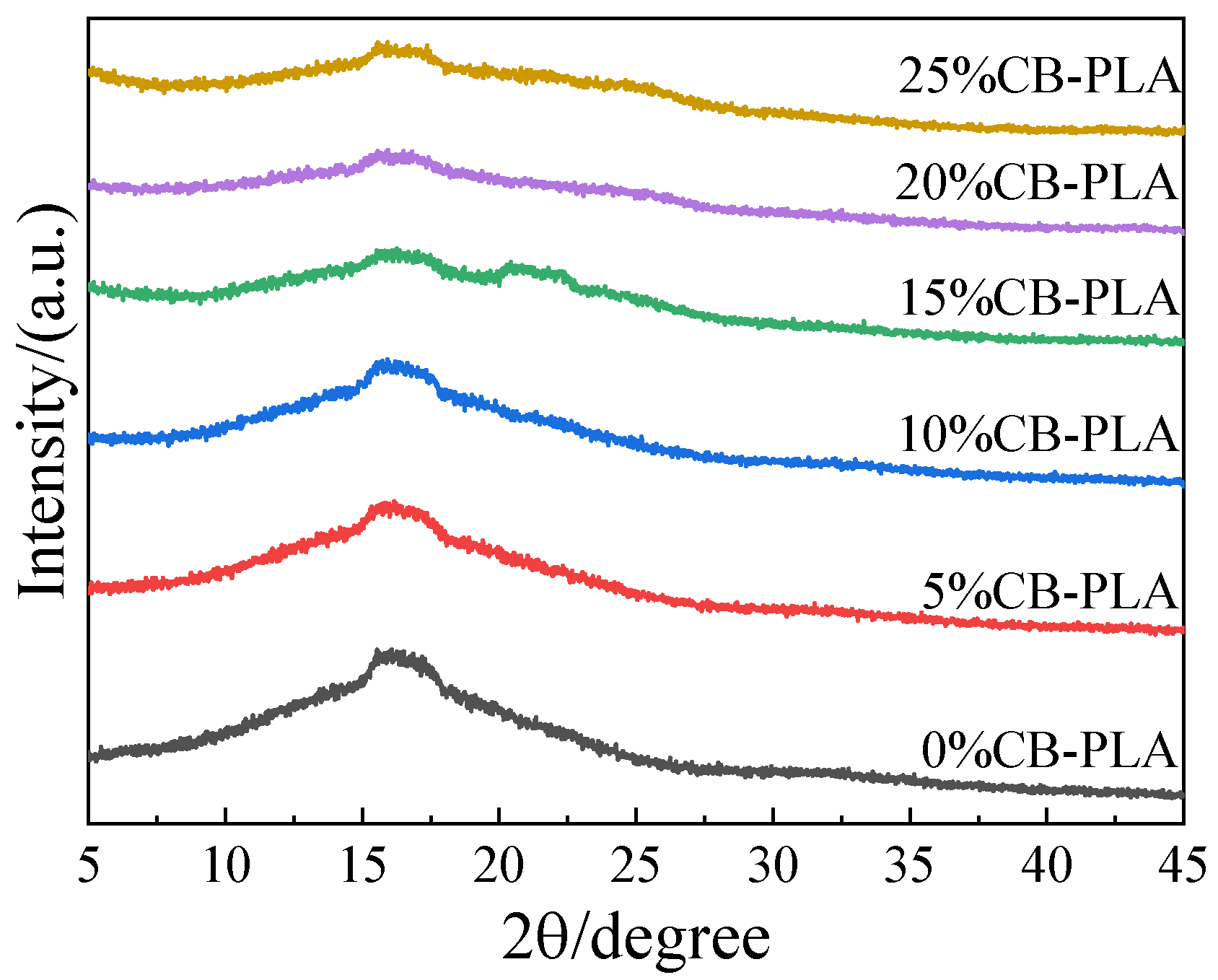
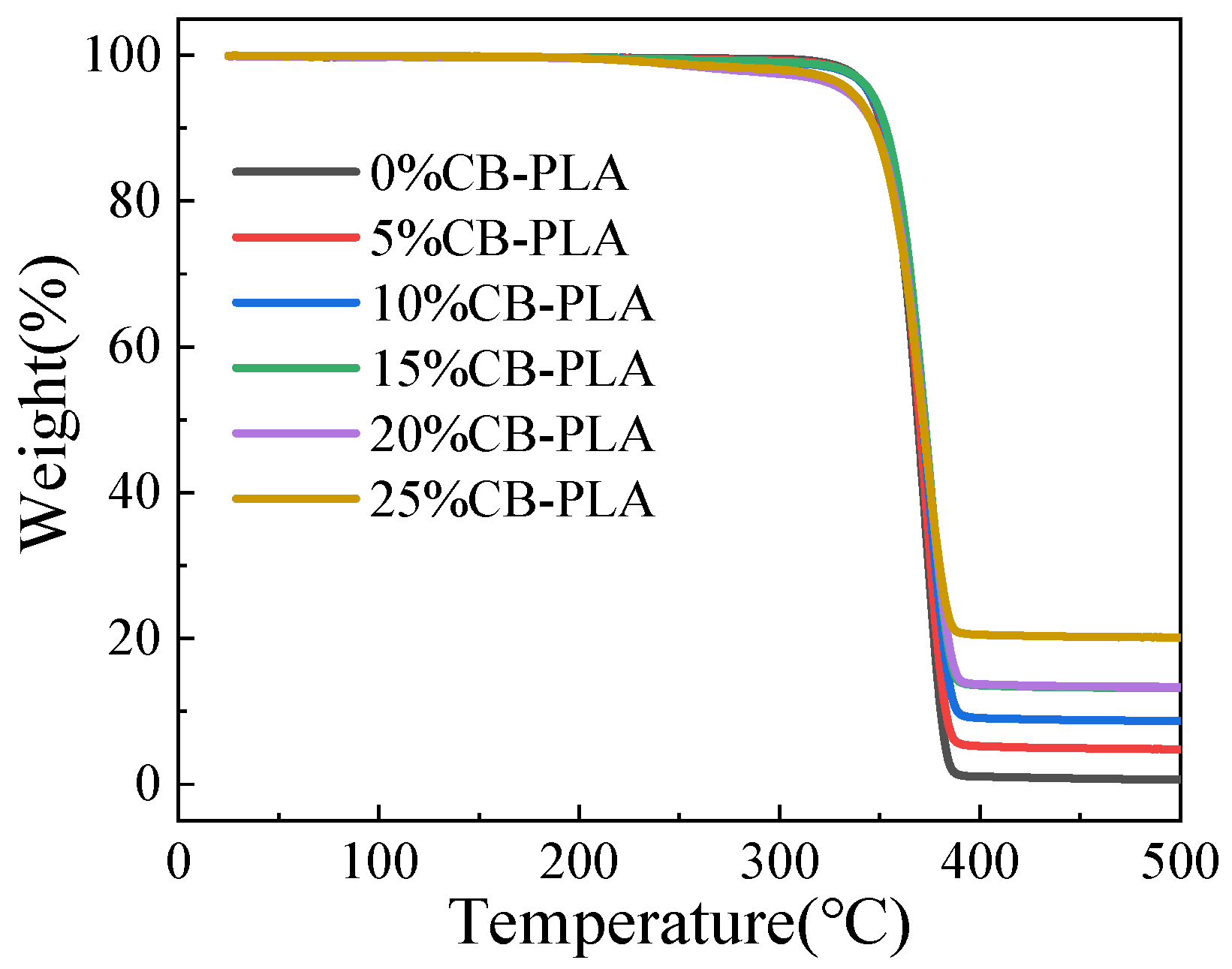

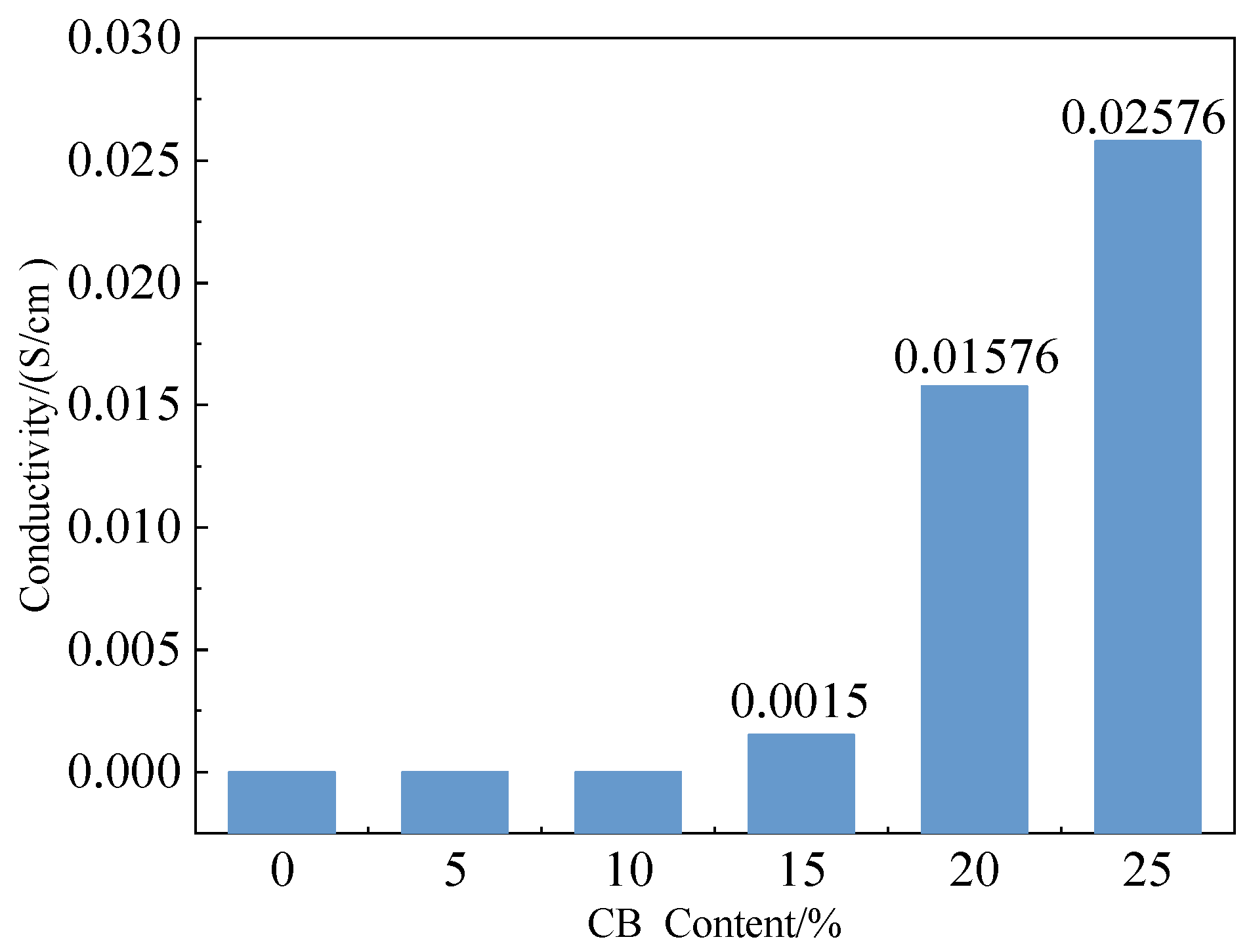
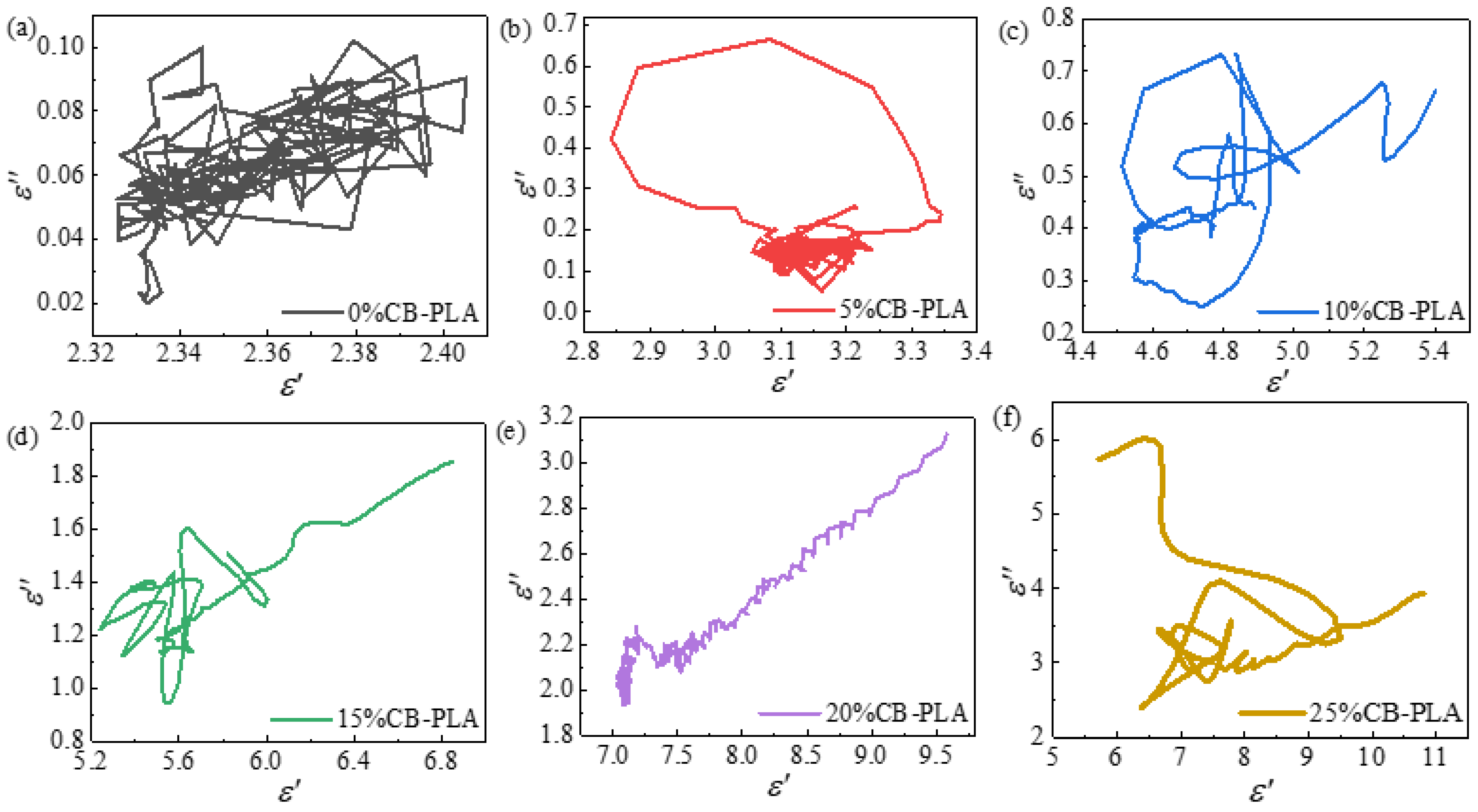

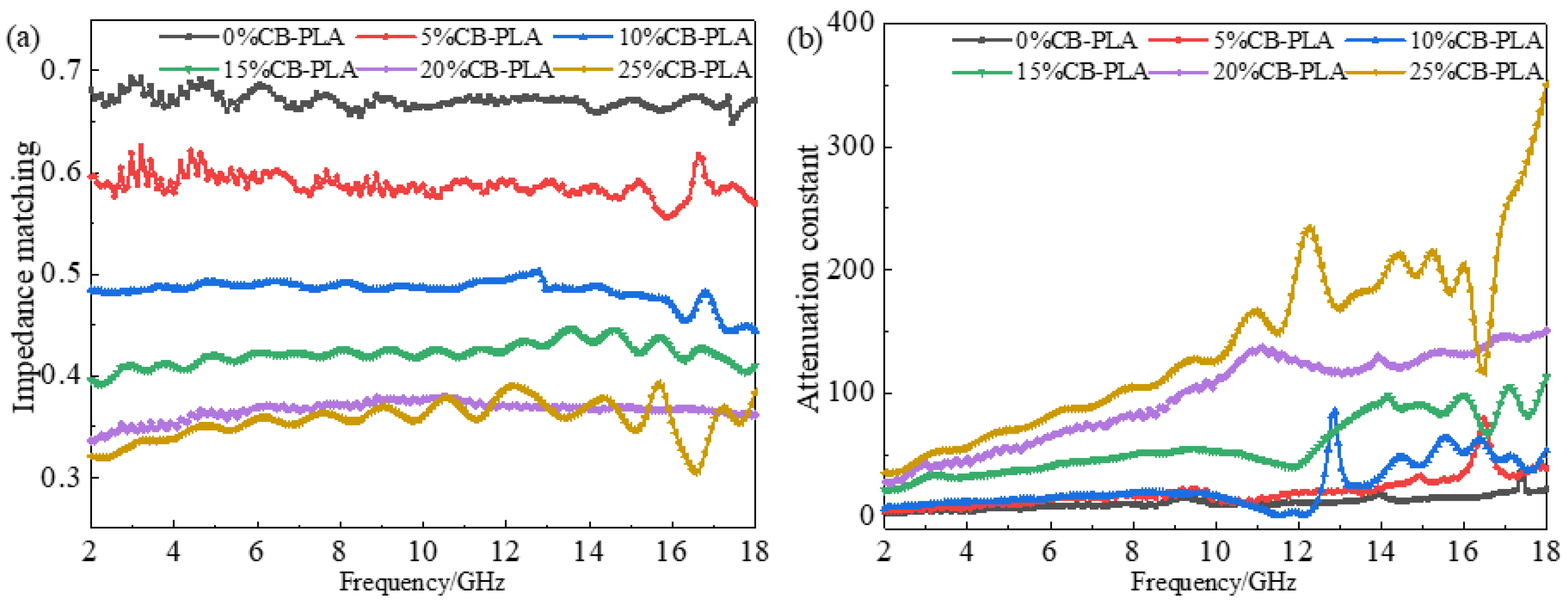

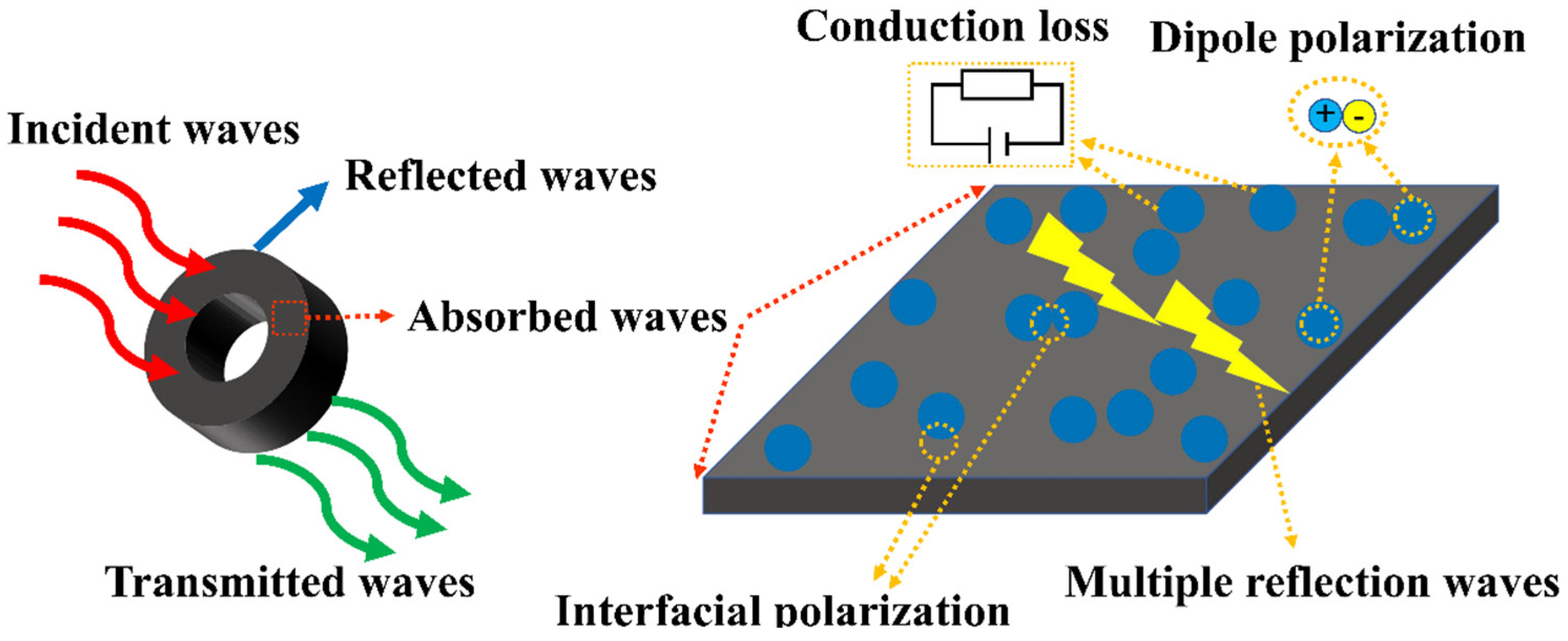
| Materials | Performance | Producer |
|---|---|---|
| PLA powder | Huachuang Plastic Technology Co., Ltd., Dongguan, China | |
| CB | specific surface area 55–70 m2/g, resistivity 2.5 Ω∙m | Zhengyuan Technology Co., Ltd., Tianjin, China |
| Aluminate coupling agent (AL) | Feiteng Chemical Co., Ltd., Nanjing, China |
| Samples | CB/% | CB/% Refers to Total | AL/% |
|---|---|---|---|
| 0% CB/PLA | 0 | 0 | 2 |
| 5% CB/PLA | 5 | 4.76 | 2 |
| 10% CB/PLA | 10 | 9.09 | 2 |
| 15% CB/PLA | 15 | 13.04 | 2 |
| 20% CB/PLA | 20 | 16.67 | 2 |
| 25% CB/PLA | 25 | 20 | 2 |
| Absorber and Content | EAB/GHz | Minimum RL/dB | Thickness at Minimum RL/mm | Reference |
|---|---|---|---|---|
| (6%) CB/CF/EP | 2.4 | −31.8 | 2 | [50] |
| (7%) CB/T-ZnO/EP | 4.25 | −17.36 | 3 | [51] |
| (30%) CB/nmCIP/PU | 3.6 | −25.8 | 2 | [52] |
| (5.5%) CB/SiO2f/PI | 3.95 | −46.18 | 1.6 | [53] |
| (8%) CB/PAN/EP | 6.7 | −17.0 | 6.3 | [54] |
| (30%) CB/CNTs | 4.1 | −53.6 | 2.7 | [55] |
| (17%) CB/EP | 0.6 | −32.1 | 3 | [56] |
| (25%) CB/PLA | 5.36 | −45.47 | 2.1 | This work |
Publisher’s Note: MDPI stays neutral with regard to jurisdictional claims in published maps and institutional affiliations. |
© 2022 by the authors. Licensee MDPI, Basel, Switzerland. This article is an open access article distributed under the terms and conditions of the Creative Commons Attribution (CC BY) license (https://creativecommons.org/licenses/by/4.0/).
Share and Cite
Wang, F.; Zhou, Q.; Zhang, Z.; He, P.; Zhang, J.; Jiang, K. Microwave Absorption Performance of Carbon Black/Polylactic Acid Composite for Fused Filament Fabrication. Appl. Sci. 2022, 12, 12747. https://doi.org/10.3390/app122412747
Wang F, Zhou Q, Zhang Z, He P, Zhang J, Jiang K. Microwave Absorption Performance of Carbon Black/Polylactic Acid Composite for Fused Filament Fabrication. Applied Sciences. 2022; 12(24):12747. https://doi.org/10.3390/app122412747
Chicago/Turabian StyleWang, Fei, Qianfeng Zhou, Zhe Zhang, Peiwen He, Jiliang Zhang, and Kaiyong Jiang. 2022. "Microwave Absorption Performance of Carbon Black/Polylactic Acid Composite for Fused Filament Fabrication" Applied Sciences 12, no. 24: 12747. https://doi.org/10.3390/app122412747
APA StyleWang, F., Zhou, Q., Zhang, Z., He, P., Zhang, J., & Jiang, K. (2022). Microwave Absorption Performance of Carbon Black/Polylactic Acid Composite for Fused Filament Fabrication. Applied Sciences, 12(24), 12747. https://doi.org/10.3390/app122412747





